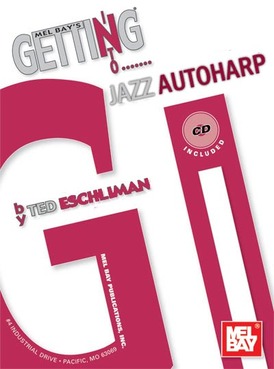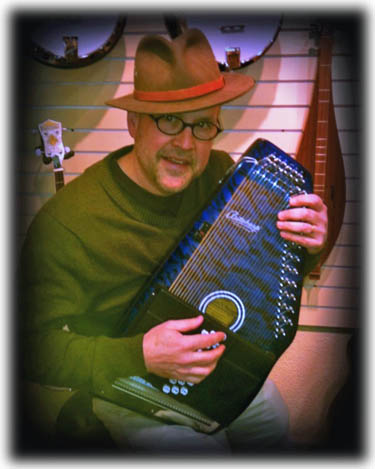« Tom Bekeny; "You'd Be So Nice to Come Home to." |
Main
| Satisfaction from Nova Scotia. JM11 strings! »
 April 1, 2011 | Introducing 'Getting Into Jazz Autoharp' April 1, 2011 | Introducing 'Getting Into Jazz Autoharp'
EDITOR'S NOTE: BE ADVISED THE FOLLOWING IS A PARODY. IF YOU'LL LOOK AT THE DATE, IT WAS PUBLISHED ON APRIL FOOLS DAY, 2011
As we mentioned last week, we are continually evolving the JazzMando website in our efforts to break new ground in the world of acoustic string music. Our latest direction takes us into new sonic frontiers with a highly under-appreciated instrument, the simple folk autoharp. To bring this musical treasure to new audiences, we are announcing our new book, and the promise of more online lessons and support to bring you along side with us to blaze trails in this wood and steel sonic journey.
Look for new barriers to be broken down as we bring forth unto the world:
THE JAZZ AUTOHARP...
NEW:
 Product Description: Product Description:
No longer confined to basic folk genres, any autoharpist aspiring to a broader comprehension of music, including swing, blues, pop, klezmer, broadway, and even a rousing edition of the birthday song can expand his/her playing and beyond a working knowledge of arguably esoteric jazz fundamentals. This breakthrough approach in autoharp pedagogy takes on uncomplicated fretboard patterns (OFcP) and drills a physical familiarity into the player's index finger, softening the fear of the outward chord buttons and prepares for the harmonic alterations necessary for effective and intuitive playing of more complex contemporary music.
A brief introduction into modes (both of them), the player is eased into reckless abandon and improvisation with audio accompaniment (High Def cassette tape included), and eventually an initiation into a popular variation of the most fundamental jazz chord progression of all, the 'IV V I' pattern. From the horizontal (holding the autoharp up and down) to the vertical (holding it sideways) and back, the results are a both instinctive and physical grasp of buttons and the potential for improvisational fodder of effective performing. An emphasis on index finger strength, left arm balance, the book's exercises also develop the player's spatial concepts of buttons and chord symbols.
Simplifying the Real Book
Many are confounded by the complexities of the jazz language, the extended chord symbols, all those hypothetical suffixes of (b13)#9 and m7b2. What isn't common knowledge is you can reduce these down to simple major and minor chords with an occasional 7 and most in the audience will never be able to tell. Simply knowing the correct roots you can reinterpret chords at a level a less sophisticated culture can understand.
Not convinced? Just listen to today's rap music.
Chord Subsitutions
Chords are simply a common set of notes stacked on yet another familiar set of notes, so if you know the system, an E minor on easily swaps for a C major7 when the bass is already covering the root. No need to have anything more than 21 chords and you can cover most Jazz standards, especially from the repertoire of legends like Kenny G or the edgier, hipper Self-Indulgent Jazz of George Winston.
Strum Techniques
Fretted instrumentalists struggle needlessly with variations of Down Up Down Up (DUDU), but the autoharpist need only worry about one stroke, the "across" stroke. Book 2 (publish date TBA) will cover the more advanced "Across Back Across Back."
Stock "IV V7" I progressions.
Whole careers were launched on 3-chord progressions, and with some minor variations on the Across, Across, Across (AAA or AAAA)strum technique and a strong primal dance beat, you can communicate a variety of the popular standard "IV V I" like F/G/C.
More complicated jazz literature is easily addressed with the "Tacet Chord" technique.
OFcP One Finger Close Position
Devoid of the need for fretted complications, the savvy autoharpist is free to vary the stock 21 chords one finger at a time. GIJA affords opportunities in the lateral shift index fingering technique (LSIF), also known as the One Finger Closed Position.
Tuning
Crap. Are you kidding? If you had any kind of ear you'd be playing another instrument, so do the right thing and pay a professional with a chromatic tuner to do this for you. Musicians that actually own their own autoharp or alto clarinet are destined to outsource such skills. Tuning?? There are some 36 strings on this thing, and besides, they're pretty good about tuning them at the factory before they leave. (Some say the tuning pins are just for show, anyway.)
Product Number: 30995BCD
Format: Book/Cassette Set
ISBN: 078667599
UPC: 7962ZZK93664
ISBN13: 978078VS9422
Series: Getting Into
Date Published: 4/1/2011
USD: $19.99
GBP: £13.99
Euro: ¤19.99
For more information: Twitter

Posted by Ted at April 1, 2011 5:15 AM

Disclaimer: In the 'Information Age' of the 21st Century,
any fool with a computer, a modem, and an idea can
become a self-professed 'expert." This site does not
come equipped with 'discernment.'
|



